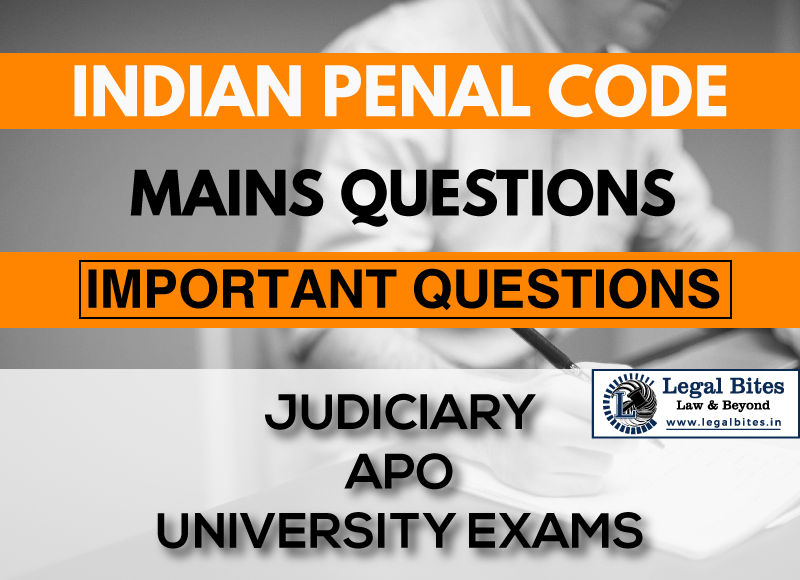Offence of voluntarily causing hurt | A boxes the ear of his friend B which caused bodily pain to B but the pain was not severe. Has A committed the offence of voluntarily causing hurt to B? Give reasons, and refer to the relevant provision/ provisions and the case law as well, if any, on the point.
Question: Offence of voluntarily causing hurt | A boxes the ear of his friend B which caused bodily pain to B but the pain was not severe. Has A committed the offence of voluntarily causing hurt to B? Give reasons, and refer to the relevant provision/ provisions and the case law as well, if any, on the point.… Read More »

Question: Offence of voluntarily causing hurt | A boxes the ear of his friend B which caused bodily pain to B but the pain was not severe. Has A committed the offence of voluntarily causing hurt to B? Give reasons, and refer to the relevant provision/ provisions and the case law as well, if any, on the point. Find the answer to the mains question only on Legal Bites. Offence of voluntarily causing hurt | [A boxes the ear of his friend B which caused bodily pain to B but the pain was not...
Question: Offence of voluntarily causing hurt | A boxes the ear of his friend B which caused bodily pain to B but the pain was not severe. Has A committed the offence of voluntarily causing hurt to B? Give reasons, and refer to the relevant provision/ provisions and the case law as well, if any, on the point.
Find the answer to the mains question only on Legal Bites. Offence of voluntarily causing hurt | [A boxes the ear of his friend B which caused bodily pain to B but the pain was not severe. Has A committed the offence of voluntarily causing hurt to B? Give reasons, and refer to the relevant provision/ provisions and the case law as well, if any, on the point.]
Answer
Section 321 provided for the offence of voluntarily causing hurt.
It says, “Whoever does any act with the intention of thereby causing hurt to any person, or with the knowledge that he is likely thereby to cause hurt to any person, and does thereby cause hurt to any person, is said “voluntarily to cause hurt”.”
From a reading of the section, it is clear that the most essential component of this section is ‘intention’ to cause hurt or the ‘knowledge’ that the act is likely to cause hurt.
If ‘intention’ or ‘knowledge’ is absent, then it will not amount to voluntarily causing hurt.
Intention to cause hurt, or knowledge that an act is likely to cause hurt is the most decisive factor to decide whether a person can be held guilty of voluntarily causing hurt. The extent of injury that is actually caused is not relevant, but what is the intention with which the hurt was caused is relevant.
There may be cases where the act may even result in death. But, if the intention of the accused as gathered from the surrounding background facts, was only to cause hurt, then the accused will be punishable only under this section and not for murder.
As per section 323, voluntarily causing hurt is punishable with simple or rigorous imprisonment, which may extend to one year or with a maximum fine of one thousand rupees or both.
Section 39 outlines the scope of the “Voluntary” act of a person. The sweep of the word voluntarily is bigger than that of the word intentionally. Every act performed voluntarily means-
- the act was done intentionally
- the act was done with the knowledge of end result being a crime
- the act was done when the doer had reason to believe that act so done would be an offence.
Section 319 of the Indian Penal Code, 1860 defines hurt as: “whoever reasons bodily pain, disorder or disease to any man or woman is said to have caused harm.” To constitute hurt (battery under English Law) any of the following essentials needs to be caused:-
- Bodily pain, or
- Disease, or
- Infirmity to another.
The definition of hurt covers bodily pain except for so slight a harm of which no person of ordinary sense or temper would complain of. However, the degree or severity of pain is not a material factor. So, in the present case, A is said to have committed the offence of ‘voluntarily causing hurt’ to B because of the following reasons:
- he had essential intention to cause hurt
- had sufficient knowledge that his act is likely to cause hurt
- because of this intentional act of A, bodily pain is caused to B
Important Mains/Long Questions and Answers for Judiciary, APO & University Exams
- IPC Mains Questions Series Part I: Important Questions
- IPC Mains Questions Series Part II: Important Questions
- IPC Mains Questions Series Part III: Important Questions
- IPC Mains Questions Series Part IV: Important Questions
- IPC Mains Questions Series Part V: Important Questions
- IPC Mains Questions Series Part VI: Important Questions
- IPC Mains Questions Series Part VII: Important Questions
- IPC Mains Questions Series Part VIII: Important Questions
- IPC Mains Questions Series Part IX: Important Questions
- IPC Mains Questions Series Part X: Important Questions

Admin Legal Bites
Legal Bites Study Materials correspond to what is taught in law schools and what is tested in competitive exams. It pledges to offer a competitive advantage, prepare for tests, and save a lot of money.
